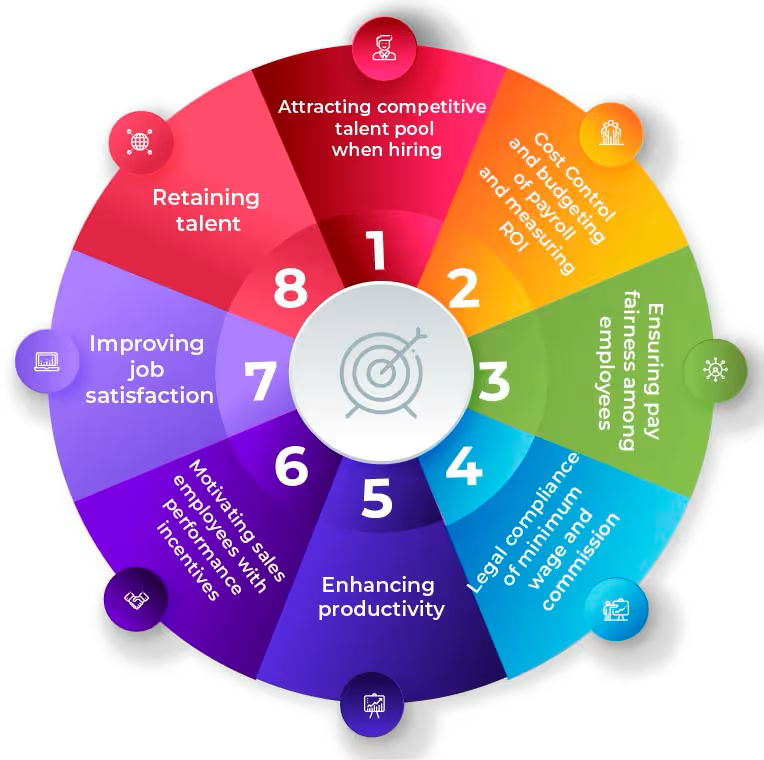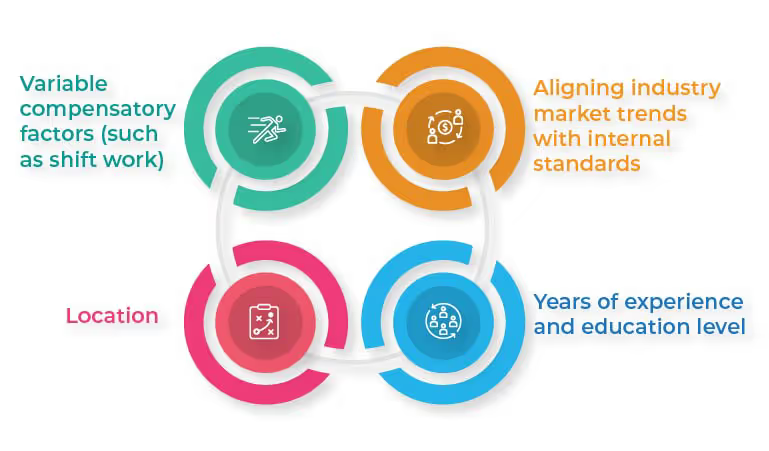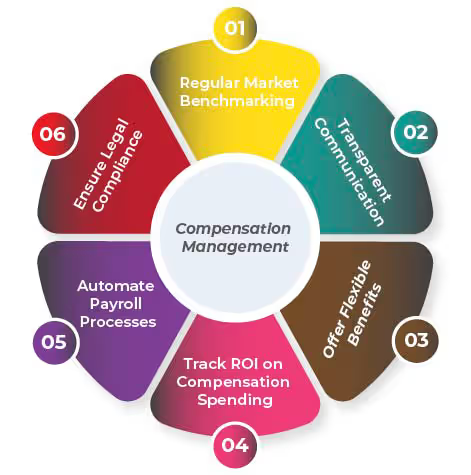
Blog
Compensation Management: Key Strategies, Types, and Tips
October 7, 2024


Key Insights
Compensation Management: Strategies, Types, and Key Objectives
Compensation management- sounds like a fancy corporate term, right? But it's the backbone of how organizations keep their employees happy, motivated, and financially secure.
Did you know that 96% of employees say compensation is either important or very important to their overall happiness at work? Yup, no surprise there!
So, when it comes to compensation, you’ve got to get it right!
Compensation management includes everything from salaries and bonuses to benefits and perks, all working together to ensure employees feel valued.
So, how does this all come together? Let's break it down, piece by piece!
What is Compensation Management?
Compensation management is the system a company uses to ensure that employees are paid fairly, competitively, and in compliance with regulations. It covers direct payments, like wages and bonuses, as well as indirect payments, such as health insurance and retirement benefits. The goal? To keep employees satisfied, motivated, and aligned with the company's objectives.
Why is Compensation Management Important?
- Attracts Top Talent
Everyone wants to work for a company that values their contributions, and a solid compensation plan makes that clear.
- Boosts Employee Morale and Retention
Fair and competitive compensation keeps employees happy.
- Improves Productivity & Engagement
Disengaged employees cost the world $7.8 trillion a year in lost productivity, equivalent to 11% of global gross domestic product. It’s simple, happy employees work harder and stay longer.
Objectives of Compensation Management

- Attracting a Competitive Talent Pool When Hiring
Offering competitive salaries and benefits is crucial in attracting skilled professionals. For example, tech companies offering stock options and sign-on bonuses attract top talent in the industry.
- Cost Control and Budgeting of Payroll, Measuring ROI
A well-managed compensation strategy ensures you're not overpaying or underpaying employees. It balances cost while maximizing return on investment in talent.
- Ensuring Pay Fairness Among Employees
Equal pay for equal work is not just a legal requirement but a trust-building tool within teams. Internal pay audits can help avoid wage gaps.
- Improving Job Satisfaction
When employees feel valued financially, their job satisfaction and loyalty increase.
💡 Check out this interesting read on: 5 Effective Sales Compensation Trends for Modern Businesses
How is Compensation Determined?

Several factors come into play when determining compensation:
- Aligning Industry Market Trends with Internal Standards:
Companies often benchmark against industry salaries to stay competitive. For example, a marketing manager in New York typically earns 15% more than their counterpart in a smaller city.
- Years of Experience and Education Level:
A seasoned employee with an advanced degree will likely earn more than an entry-level hire.
- Variable Compensatory Factors (such as Shift Work):
Night shift workers often earn more due to the irregular hours.

- Location:
Compensation varies significantly by location. A software engineer in Silicon Valley might earn twice as much as one in a rural area due to the cost of living and demand.
The Cost of Not Offering Competitive Compensation
Skimping on compensation is like pulling the rug out from under yourself, you're bound to trip! Take an entry-level employee making $20,000 a year. If they decide to jump ship, you’re suddenly staring down a $6,000 to $10,000 bill just to replace them. Ouch, right?
Now, imagine that happening with a few more employees. Pretty soon, those replacement costs are stacking up into the hundreds of thousands, and that's not even counting the hit your productivity and morale take in the meantime. Long story short: underpaying can cost you way more than paying fairly ever would!
What are the Main Types of Compensation?

Compensation can take many forms, but it typically breaks down into three categories: direct compensation, indirect compensation, and total compensation.
- Direct Compensation: This is the most obvious type, of money in the form of wages, salaries, bonuses, and commissions. It’s the cash you see in your paycheck every month.
Example: A sales associate earns a base salary of $50,000 per year, plus a 10% commission on all sales. Last year, their total earnings were $80,000 because they exceeded their sales targets.
- Indirect Compensation: These are the benefits and perks that don’t show up as cash but are still valuable. This includes health insurance, retirement plans, and paid leave. It’s often the deciding factor for employees when choosing between job offers.
Example: A job offers health insurance worth $8,000 annually, which covers the employee and their family. This indirect compensation saves the employee from paying out-of-pocket for medical expenses.
- Total Compensation: This is the sum of both direct and indirect compensation. When companies advertise their total compensation packages, they include base salary, bonuses, and all the benefits that come along with the role.
Example: An employee earning $70,000 in salary and $20,000 worth of benefits has a total compensation package of $90,000.
What can HR Leaders Do to Ensure Effective Compensation Management?
HR leaders need to stay informed on market trends, continuously review internal pay structures, and implement feedback from employees to ensure compensation packages remain competitive.
How to Implement a Compensation Management Strategy
✅Audit Existing Compensation Plans:
- Review current salaries and benefits to identify gaps.
✅Set Clear Compensation Goals
- Align these with the company’s financial situation and talent needs.
✅Use Market Data
- Leverage salary benchmarking tools to stay competitive.
✅Engage Employees
Get feedback to understand what matters most to them, this could be bonuses, flexible working hours, or better health benefits.
✅Automate with Technology
Use compensation management software to reduce human error and improve efficiency.
What is Compensation Management Software?
The Compensation management software automates a ton of manual processes that typically result in headaches and miscalculations, especially when you’re manually entering data, tracking various laws, or trying to figure out who’s eligible for what.
The challenge with manual processes? Miscalculations are common, and the manual hours spent checking and rechecking numbers are exhausting. That’s a recipe for disaster, or at least, a very stressed-out HR, admin team.
Kennect is an Incentive Compensation Management (ICM) tool that saves the day by automating the entire process. Kennect streamlines everything from salary structure setups to commission payments, taking the guesswork (and manual errors) out of the equation.
By doing so, not only improves accuracy but also slashes the number of hours your team spends managing compensation. You could say it’s like giving your HR department a productivity superpower.
With Kennect, no more spreadsheets, no more manual mistakes, and no more unnecessary hours wasted on payroll and incentives. Sound too good to be true? You can get a free demo to see how it works in action, and you'll wonder how you ever managed without it!
6 Best Practices for Compensation and Benefit Management

To help you hit the mark, here are 8 best practices for compensation and benefit management. These strategies can guide you in designing, implementing, and refining your approach to pay and perks, ensuring your company stays competitive, compliant, and, most importantly, a great place to work.
- Regular Market Benchmarking
- Transparent Communication with Employees
- Offer Flexible Benefit Options
- Legal Compliance Checks
- Automate Payroll Processes
- Internal Pay Equity Audits
- Track ROI on Compensation Spending
Food For Thought!
People are the beating heart of every organization. No ifs, ands, or buts about it! If you want to grow your business and reach for the stars, you need a crew of talented individuals who aren’t just in it for a paycheck. Luring these rockstars into your fold can be done with the magic ingredient: compensation!
As the wise Richard Branson once said, “Train people well enough so they can leave, treat them well enough so they don’t want to.”
Compensation management is more than a mundane task, it’s a high-stakes game of strategy! Salary structures, performance bonuses, and benefits galore. With all these moving parts, it’s easy to feel overwhelmed, but nail it, and you’ll cultivate an environment where employees don’t just clock in and out; they thrive!
ReKennect : Stay ahead of the curve!
Subscribe to our bi-weekly newsletter packed with latest trends and insights on incentives.
Thank you! Your submission has been received!
Oops! Something went wrong while submitting the form.
Your data is in safe hands. Check out our Privacy policy for more info













